Hybrid Working
Create a hybrid way of workingDeveloping a culture of inclusion in organisations moving towards hybrid working
Key recommendations
- Adopt a co-design approach with staff involvement.
- Run representative, honest and open focus groups.
- Scope what your organisation and people are able to change.
- Detail the changes required – for your organisation, people and resources.
- Create a hybrid working blueprint and get people’s feedback.
- Trial hybrid working in practice and review it periodically over time.
Download resources
Co-design is “… when an individual influences the support and services received, or when groups of people get together to influence the way that services are designed, commissioned, and delivered.”
Care Act 2014 statutory guidance.
Who is this for?
Primary audience:
Small businesses,
Voluntary sector
Secondary audience:
Larger organisations,
Public sector
Roles:
CEO, COO, MD, managers,
leaders, HR, wellbeing leads
CONTEXT: WORKING IN A POST-PANDEMIC WORLD
The Covid-19 pandemic has changed how organisations and their staff think about work.
Much of the research before the pandemic looked at how businesses/charities could embrace ‘remote’ or ‘tele’ working. But there is a combination of remote and office work that became common during the pandemic, and could benefit more working environments in the future, called ‘hybrid’ working. This blended approach, combining time at the office and away from it, may offer some advantages for both organisations and their people. But how do you design a work culture that incorporates elements of both in a way that’s fair to your organisation and your employees, maximising outcomes for both? How do you gain the benefits that hybrid working can offer, without losing cohesion and creativity along the way?
Hybrid working offers an opportunity to re-imagine the workplace and work culture.
Benefits for employees include:
- flexibility with time and location
- enhanced work-life balance
Benefits for employers include:
- reducing office space overheads
- more motivated employees.
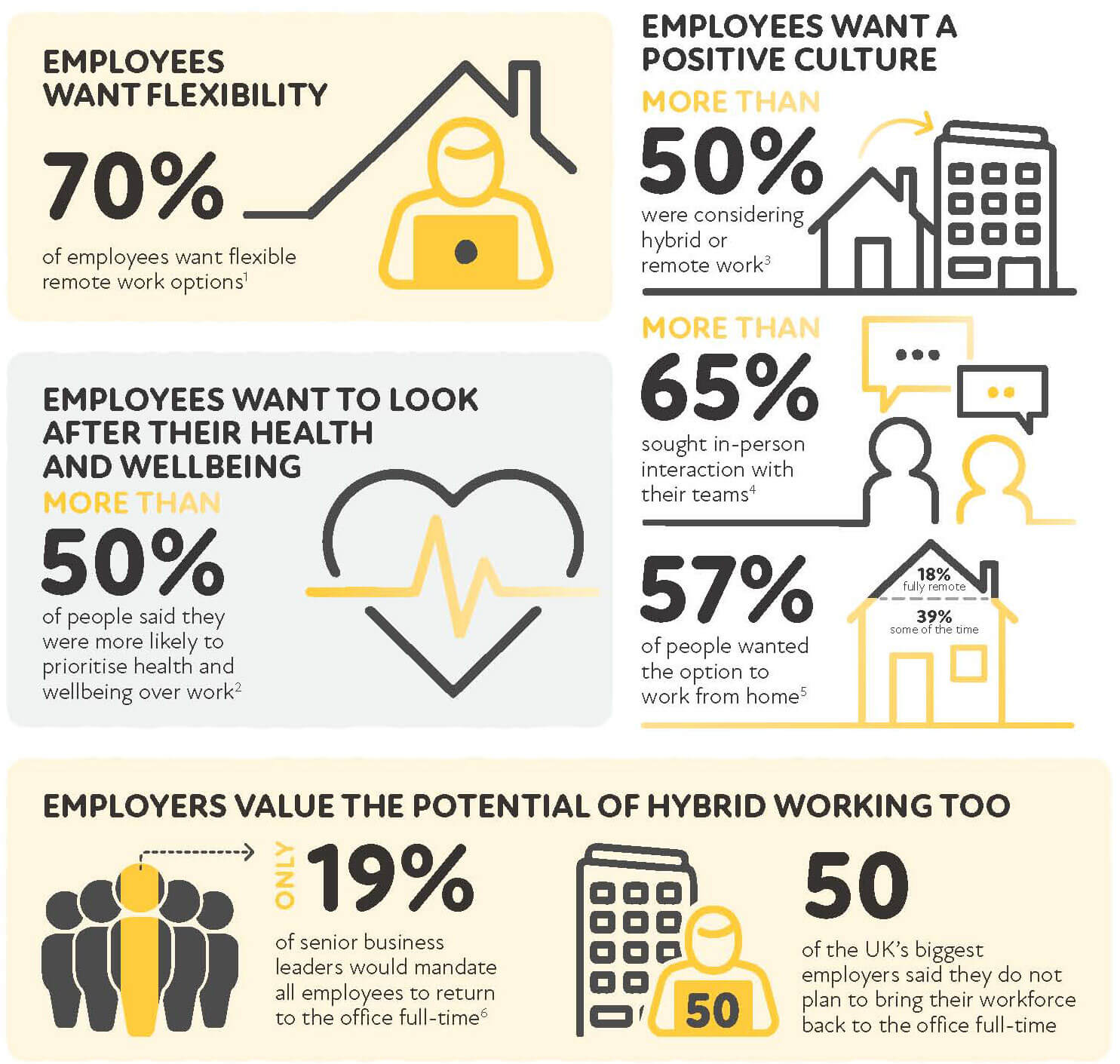
Employers adapted rapidly to the ‘shocks’ of the pandemic in order to stay in business. They dealt with challenges as they arose, without a clear strategy or plan in place to navigate the transition to a longer-term hybrid work culture.
But you do need a plan. Without one you may struggle to:
- recruit and retain staff
- ensure a fair and inclusive workplace
- meet your organisation’s goals and outcomes sustainably and effectively.
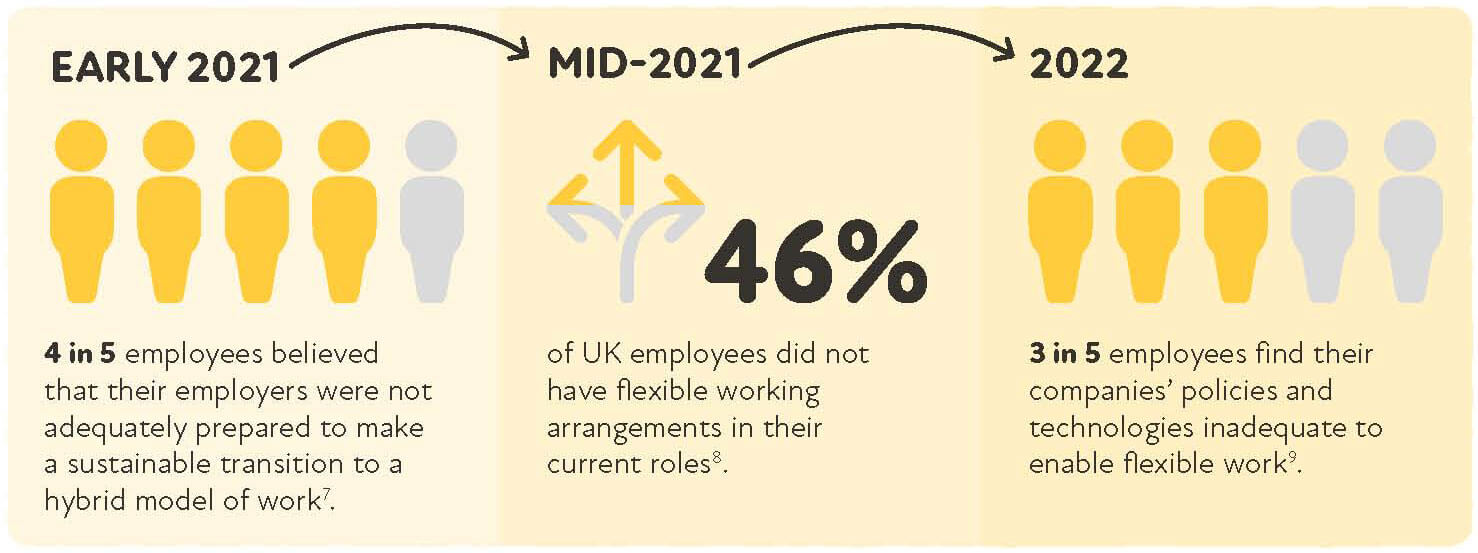
There are practical challenges around technology, infrastructure and ‘culture shift’ needed. Organisations are trying to cultivate new and creative ways to communicate and collaborate. This means fostering sustainable engagement between team members.
So, what does this mean for SMEs in particular?
There has been heightened stress, compassion fatigue and burnout as a result of charities’ and frontline organisations’ intensified duties during the pandemic10.
While a majority of large private as well as public sector organisations are making hybrid working models the norm11, small business, charities and frontline organisations may not have access to this type and extent of resources – although most are looking to embrace flexible working12.
An unplanned approach to transitioning an already overwhelmed workforce could pose threats to individuals as well as an organisation’s health and wellbeing.
Using the guidelines in this document will:
- support small-and-medium enterprises (SMEs) and the voluntary/third sector in developing
a template for a flexible and hybrid culture of work. - offer a tried and tested approach to co-designing a hybrid workplace culture that is fair,
equitable and addresses the needs of the workforce. - make work more accessible, more inclusive, and more enriching to our lives.
theinclusivityproject
Adopting a thoughtful, collective response to the changing context of work can make work more accessible, more inclusive, and more enriching.
WHY ADOPT A CO-DESIGN APPROACH?
Co-designing the processes, policies and culture change with all members of the workforce will help you embed an enriched culture of work without introducing new inequalities. Co-design responds to the unique and diverse needs of the workforce, and creates individual accountability and participation in the culture change process.
Employees are prioritising their health, wellbeing, and autonomy around how they work in a post-pandemic world. Actively seeking their participation in every step of the transition process will help in:
- understanding what the barriers, challenges and gaps are
- identifying potential solutions
- trialing any new policies and practices that are developed
- supporting organisational resilience – your ability to respond to further shocks.
In their practical guidance to hybrid working, the Chartered Institute of Personnel and Development (CIPD) recommends including input from the workforce on both the organisational considerations and potential benefits to workers from the start of the process of transition14.
A co-design process is an iterative feedback loop that begins and ends with the participation of employees.
A sample co-design loop:
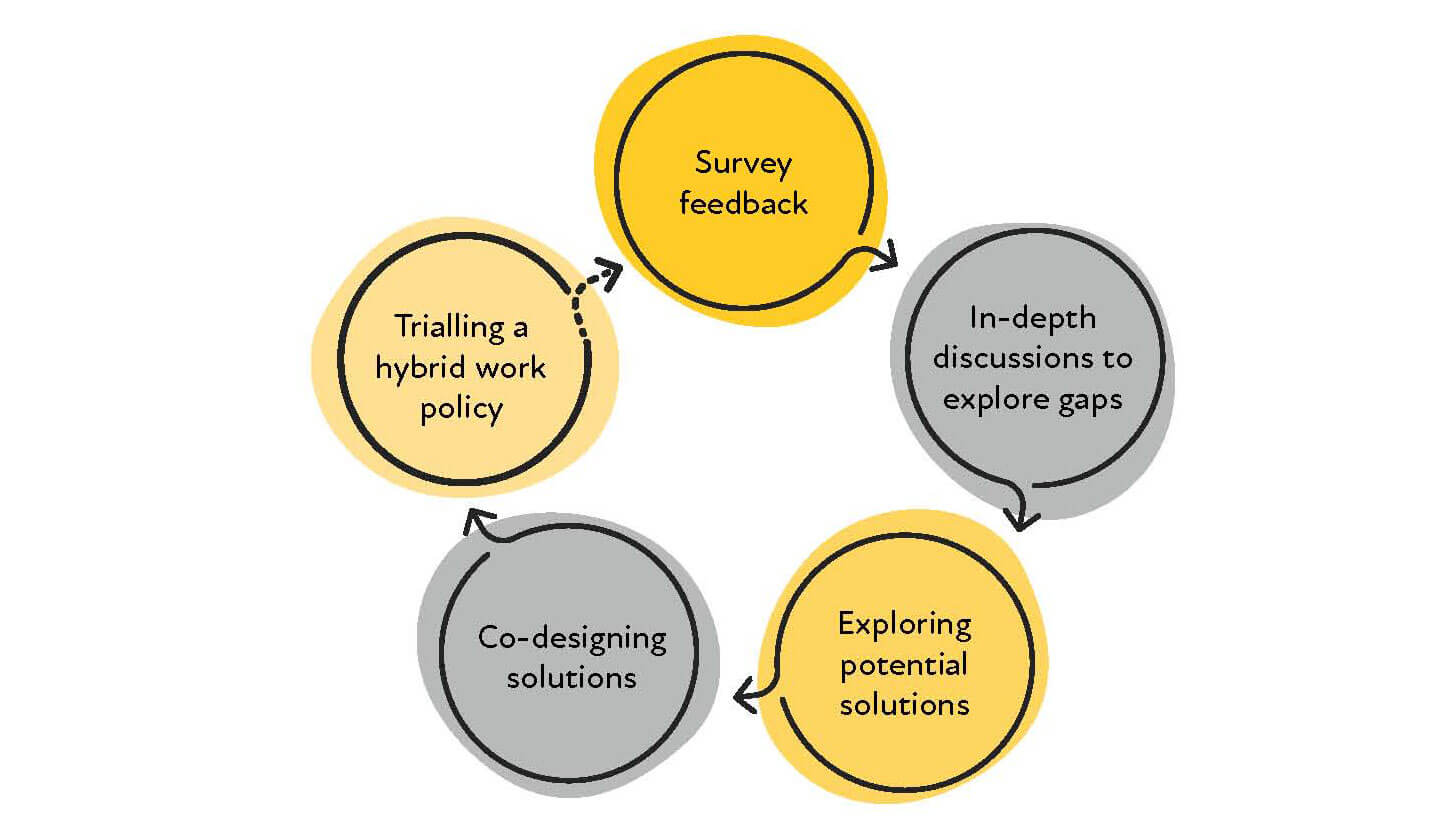
Crises are often unprecedented, but the aim of disseminating a process that can be easily adapted is to ‘future-proof’ the organisation and build resilience to shocks and crises over time. Covid-19 and the emergence of hybrid working has taught us that this can only be done successfully through collaborating and consulting with the workforce.
To this effect, the process we have designed can be adapted to, and executed as a response to any crisis or to ensure that businesses are on par with the evolving culture and environment of work. For instance, re-imagining flexibility in the workplace is as much a potential solution to Covid-19, as it is to the rising cost of living in the UK. It allows employees to fit work around their personal needs such as caring responsibilities, instead of vice versa. These needs may be unique and varied across individuals and depending on the type of role and organisation they work for. However, it is clear that prioritising the wellbeing of the workforce is key to the survival of businesses in the face of crises. The process we have designed and recommend is a means to achieve this end.
The Inclusivity Project
The Inclusivity Project is a joint piece of work, funded by the European Regional Development Fund and the South West Academic Health and Science Network. The project brings together research from the European Centre of Environment and Human Health at the University of Exeter in collaboration with our partners, Cornwall and Isles of Scilly LEP, disAbility Cornwall, Age UK Cornwall and Isles of Scilly, to support small and micro businesses in Cornwall.
The Inclusivity Project has worked to generate a better understanding of some of the challenges and opportunities facing employers in creating inclusive places to work, particularly for people who are 50+, disabled, or have a long-term health condition.
We have conducted research into unconscious bias, organisational resilience as well as a systems approach to understanding recruitment and retention of older and disabled workers in Cornwall. Further, the project’s Knowledge Exchange service has empowered SMEs to overcome the challenges and barriers they have faced in their aim to be a more inclusive workplace, both pre and post pandemic.
Since March 2021, the team has been working closely with a local, independent charity based in Cornwall and the Isles of Scilly. The charity works with the local community to support older people through a range of products and services with the aim of promoting their interests, independence and wellbeing.
- UK charity with regionalised operations
- 140 staff based in Cornwall and Isles of Scilly
- 300+ active volunteers
Aim
This resource is aimed at organisations that are seeking to develop a collaborative process of culture change. This process aims to support these organisations to –
- Develop a flexible and hybrid culture of work that is explicit, fair and equitable with enhanced positive connection and inclusion
- Adopt a planned, systematic approach while navigating the transition to hybrid working
- Utilise the opportunity to make work more accessible, more inclusive, and more enriching to our lives
Approach: Co-design
Co-designing the processes, policies and culture change with all members of the workforce is essential towards understanding how to democratically embed an enriched culture of work that doesn’t introduce new inequalities, but instead responds to the unique and diverse needs of the workforce. The co-design process also creates individual accountability and participation in the culture change process.
Co-design, also known as participatory design, is an approach that seeks to actively involve all stakeholders in the design of a process or a service that seeks to benefit them
Global surveys have indicated that employees are prioritising their health, wellbeing, and autonomy around how they work in a post-pandemic world. In order to be responsive to this change in the mindset of the workforce, a consultative and collaborative approach is recommended when designing an inclusive work culture. In their practical guidance to hybrid working, the Chartered Institute of Personnel and Development (CIPD) recommends including input from the workforce on both the organisational considerations and potential benefits to workers from the start of the process of transition (CIPD, 2021).
This involves actively seeking the participation of all employees in every step of the transition process, from understanding what the barriers, challenges and gaps are, to identifying potential solutions, to trialing any new policies and practices that are developed.
The key to understanding the co-design process is that it is an iterative, feedback loop and begins and ends with the participation of the workforce. A sample co-design loop is presented below and can be adapted and used as a framework.
Global surveys have indicated that employees are prioritising their health, wellbeing, and autonomy around how they work in a post-pandemic world. In order to be responsive to this change in the mindset of the workforce, a consultative and collaborative approach is recommended when designing an inclusive work culture. In their practical guidance to hybrid working, the Chartered Institute of Personnel and Development (CIPD) recommends including input from the workforce on both the organisational considerations and potential benefits to workers from the start of the process of transition (CIPD, 2021).
This involves actively seeking the participation of all employees in every step of the transition process, from understanding what the barriers, challenges and gaps are, to identifying potential solutions, to trialing any new policies and practices that are developed.
The key to understanding the co-design process is that it is an iterative, feedback loop and begins and ends with the participation of the workforce. A sample co-design loop is presented below and can be adapted and used as a framework.
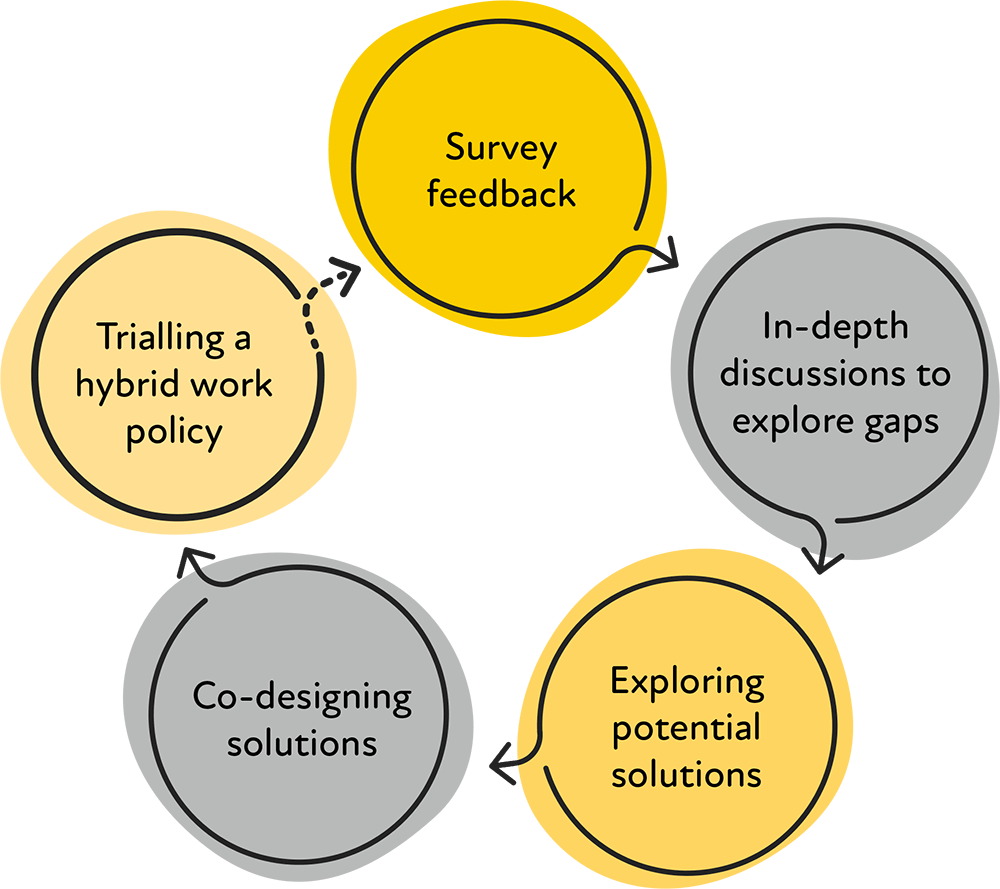
Phase 1: Survey feedback
Method: There are several ways of scoping your organisation’s unique needs and preferences. The most resource-efficient way is using a survey to get large-scale feedback. Anonymising the responses can be an effective way of ensuring honest feedback.
Sample questions can be found here.
Remember that the cultural shift to accommodate hybrid work could prove overwhelming for staff as well as your organisation. Physical workspaces must not be removed completely15. Even if you’ve already taken this step, it is worth taking these steps to make it work better for everyone.
Purpose: Think of your work culture as a spectrum, and use the survey to help gauge where on the spectrum the preferences your staff and your organisation’s capacity for change lie.

Phase 2: In-depth, facilitated discussions
Method: Use the survey results as key discussion points for a more focused, in-depth dialogue with a small sub-section of the workforce: a focus group. Ensure adequate representation from all levels of the management and staff (and volunteers, if you have them).
We recommend:
- between 10 and 12 participants in each discussion to ensure everyone has a chance to voice their perspective.
- a duration of 60-90 minutes to cover key discussion points, while engaging with all participants equally.
- multiple discussions depending on the size of your organisation as well as your team’s appetite for participation.
An iterative approach achieves both depth and focus. Make sure you share and use insights from previous discussions.
A section of a sample discussion guide is available here.
Ensure these discussions are a safe space for employees with wide-ranging roles and responsibilities to air any concerns about a transition to hybrid working. Using an external facilitator at this stage could help streamline the discussion to make it fair, equitable, honest and authentic.
Purpose: You’ll gain insight into diverse perspectives through open and active dialogue between staff. Dig deeper into issues that are important from an operational perspective, while employees can elaborate on any concerns, roadblocks or gaps.
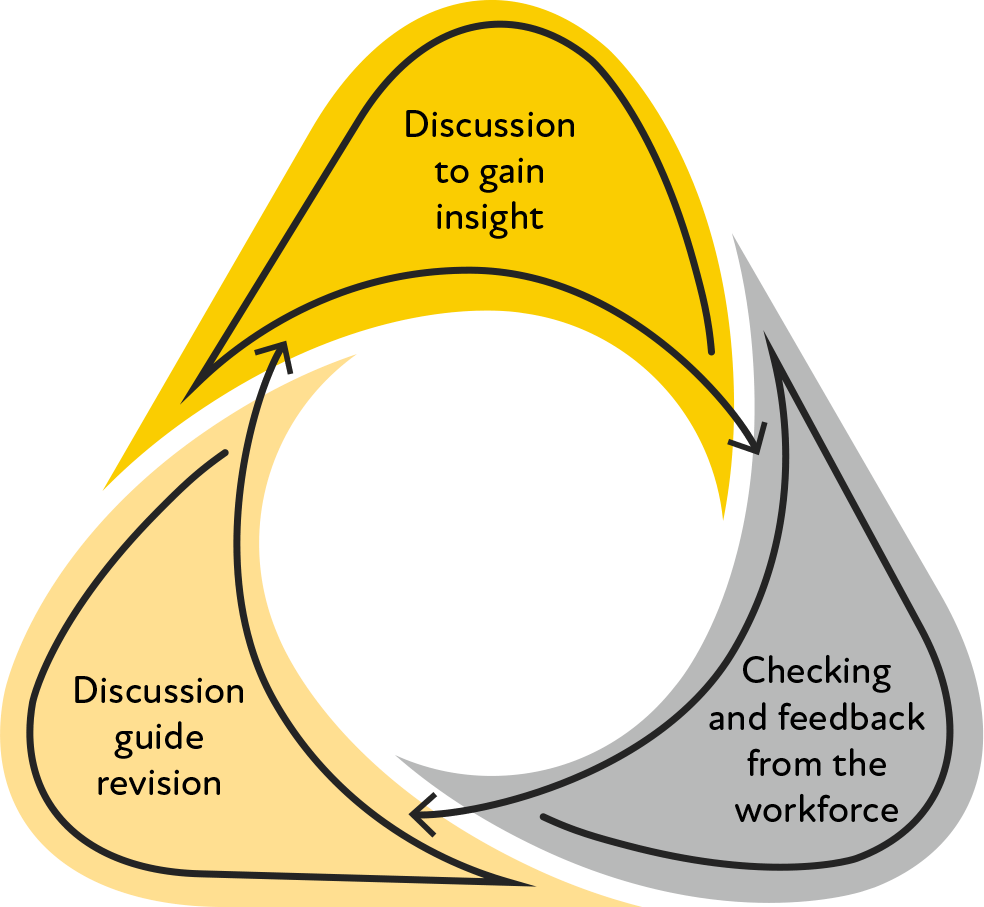
Phase 3: Identify potential solutions
Method: This phase involves the following steps:
- Revisit your organisation’s purpose and goals
- Are there any changes to the services offered, responsibilities to funders/investors, or other organisational goals and output?
- What changes need to be implemented in the short-term?
- What are the long-term goals of the organisation in the context of work culture?
- Re-examining the individual roles and responsibilities of staff
- What changes or constraints to how different staff operate and the duties or roles they perform will result from a change in work culture?
- How can your organisation take on board team/individual reassessment of their working environment, role and priorities?
- Reassessing or re-allocating your organisation’s resources
- What is realistically and pragmatically possible within the constraints of capital, funds, time and human resources?
- How and when can additional resources be mobilised to meet the demands of transition to hybrid work?
Invite feedback from the workforce to determine the overlap between what is needed and what is possible.
Purpose: Execute this process carefully to formulate a roadmap or blueprint for a formal hybrid work policy.
This means a set of explicit operating principles that is transparent and implementable. This should be:
- flexible
- adaptable
- amendable to feedback from the workforce
- explicit, yet not prescriptive
- what is realistically feasible.
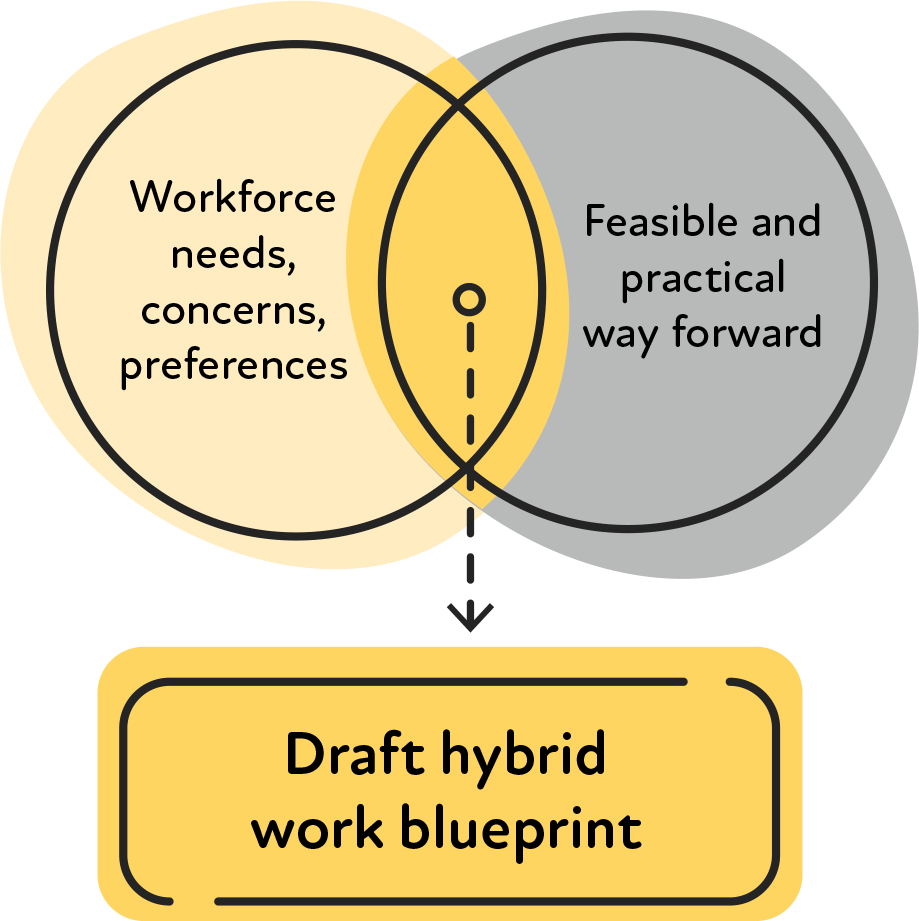
Phase 4: Co-design solutions
Method: In this phase, run a further round of facilitated, in-depth discussions with the workforce using the same structure and format as in phase 2. As in phase 2, the discussions will end when you have full engagement. You can then further revise, refine, and develop your organisation’s hybrid work policy.
Purpose: This phase will ensure your draft blueprint has the workforce’s perspective of how well their needs are being met.
Phase 5: Trial a hybrid work policy or practice
Method: Once a process, practice or service is sufficiently refined and developed, trial it with a small team. In a frontline organisation, it may be prudent to trial short-term policy changes or practices with staff who don’t have frontline roles or responsibilities. Refine it before rolling out across your organisation. Remember that this is unique to your organisation; not a one size fits all approach.
Build in opportunities for review, feedback and revision within the trial process. This will help you recover from a potentially failed process or change. It’s also useful as a regular way to connect with and invite feedback from the workforce on a variety of issues not restricted to hybrid work.
Purpose: A hybrid work policy is not a static document, but a live and constantly evolving practice.
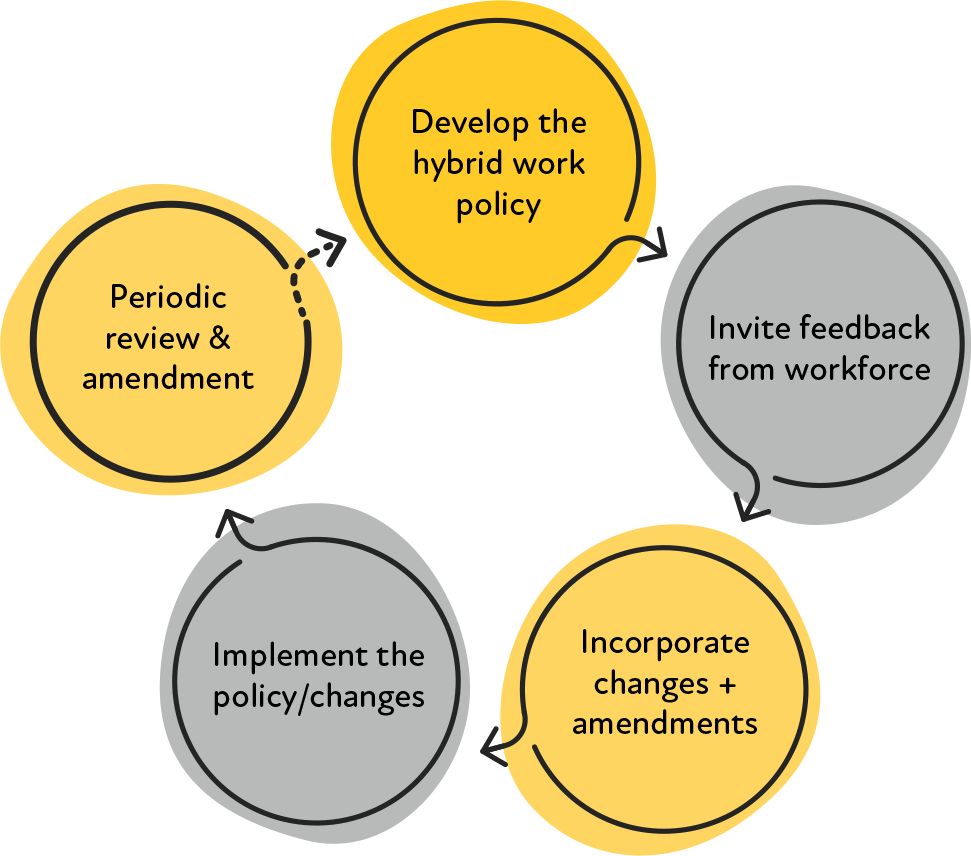
Remember:
- Culture change is a slow process.
- Funds and other resources often determine the speed and intensity of a transformation.
- It is not possible to incorporate every view and desire into the strategy or culture.
- Create expectations of adjustments over time to ensure that the workforce feels supported and engaged.
- Build in periodic reviews and amendments to close the feedback loop.
References
- Microsoft. (2021). The Next Great Disruption is Hybrid Work – Are We Ready? In Microsoft 2021 Work Trend Index. https://ms-worklab.azureedge.net/files/reports/hybridWork/pdf/2021_Microsoft_WTI_Report_March.pdf
- Microsoft. (2022). In Microsoft 2022 Work Trend Index Survey.
- Microsoft. (2022). In Microsoft 2022 Work Trend Index Survey.
- Microsoft. (2021). The Next Great Disruption is Hybrid Work – Are We Ready? In Microsoft 2021 Work Trend Index. https://ms-worklab.azureedge.net/files/reports/hybridWork/pdf/2021_Microsoft_WTI_Report_March.pdf
- Smith, M. (2020). Most workers want to work from home after Covid-19. YouGov. https://yougov.co.uk/topics/economy/articles-reports/2020/09/22/most-workers-want-work-home-after-covid-19
- Nolsoe, E. (2021). One in four businesses intend to allow all workers to work from home at least some of the time. YouGov. https://yougov.co.uk/topics/economy/articles-reports/2021/07/29/one-four-businesses-intend-allow-all-workers-work-
- Faragher, J. (2021, January 20). A fifth of workers feel employer prepared for hybrid working – Personnel Today. Personnel Today. https://www.personneltoday.com/hr/a-fifth-of-workers-feel-employer-prepared-for-hybrid-working/
- CIPD. (2021a). Flexible working arrangements and the impact of the COVID-19 pandemic. CIPD. https://www.cipd.co.uk/knowledge/fundamentals/relations/flexible-working/flexible-working-impact-covid#gref
- O’Halloran, J. (2022, March). Manufacturers reveal concerns over tech readiness for hybrid work. ComputerWeekly.com. https://www.computerweekly.com/news/252515241/Manufacturers-reveal-concerns-over-tech-readiness-for-hybrid-work?utm_campaign=20220408_Userreg+-+SS-WELCOME&utm_medium=EM&utm_source=SS-WELCOME&src=9509625&asrc=EM_SS-WELCOME_215208192
- Ricketts, A. (2021, January 20). Nine in 10 charity workers have felt stress, overwhelm or burnout over the past year, survey shows |. Third Sector. https://www.thirdsector.co.uk/nine-10-charity-workers-felt-stress-overwhelm-burnout-past-year-survey-shows/management/article/1705083
- HubbleHQ. (2022). The Official List of Every Company’s Back-to-Office Strategy. HubbleHQ. https://hubblehq.com/blog/famous-companies-workplace-strategies#google
- NCVO, Acevo, & Starfish. (2019). Time to flex: Embracing flexible working: Benefits and barriers in the voluntary sector. In BDJ In Practice (Vol. 32, Issue 11). https://doi.org/10.1038/s41404-019-0232-z
- Amar, Z., The Skills Platform, & Ramsay, N. (2021). Charity Digital Skills Report 2021.
- CIPD. (2021b). Hybrid working: Practical guidance (Issue November).
- Churchill, F. (2021, May 7). Remote working “must not be enforced”, experts warn, as large employers plan hybrid future. People Management. https://www.peoplemanagement.co.uk/article/1747224/remote-working-must-not-be-enforced-experts-warn-as-large-employers-plan-hybrid-future
Access our digital resource on hybrid working
The tools: A hybrid working toolkit
Age UK Cornwall and Isles of Scilly have needed, as an organisation, to adapt to a hybrid way of working. But there are advantages and disadvantages to the over-50s workforce of a tech-based working solution. So how have they negotiated this difficult transition?
The Inclusivity Project’s research fellow Dr. Shruti Raghuraman facilitated co-creation discussions within Age UK Cornwall and Isles of Scilly.
The aim was not simply to create a hybrid working solution for Age UK Conrwall & IoS, but also to use the collaborative methodology to provide a toolkit so that other organisations could work with their staff to manage the transition to hybrid work.
Tracey Roose, CEO of Age UK Cornwall and Isles of Scilly, describes their hybrid working challenges.
